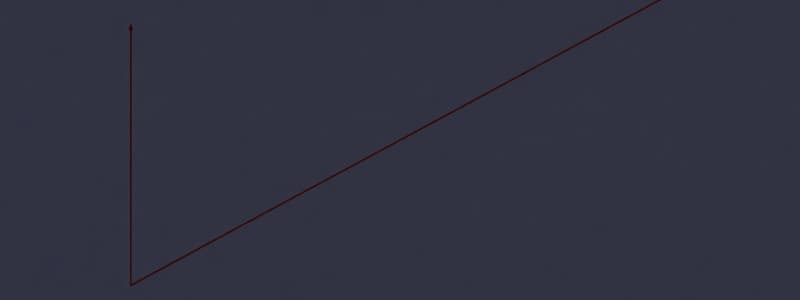Podcast
Questions and Answers
In linear regression, what does the method of least squares try to achieve?
In linear regression, what does the method of least squares try to achieve?
- Maximize the sum of the residuals.
- Ensure all residuals are positive.
- Minimize the total squared difference between observed and predicted values. (correct)
- Make the mean of residuals as large as possible.
Why is it important to square the residuals in linear regression before summing them, rather than simply adding the raw residuals?
Why is it important to square the residuals in linear regression before summing them, rather than simply adding the raw residuals?
- Squaring the residuals makes the values easier to compute.
- Squaring the residuals prevents positive and negative residuals from canceling each other out. (correct)
- Squaring the residuals gives more weight to smaller errors.
- Squaring the residuals always results in a sum of zero.
What condition must be met when using linear regression?
What condition must be met when using linear regression?
- There should be many outliers.
- Both variables must be quantitative. (correct)
- The relationship between variables should be non-linear.
- One variable must be categorical, and the other must be quantitative.
Identify the correct description of a 'regression line'.
Identify the correct description of a 'regression line'.
Consider a scenario where SSE (Sum of Squared Errors) is calculated for two different linear regression models on the same dataset. Model A has an SSE of 500, while Model B has an SSE of 300. What can be inferred from this information?
Consider a scenario where SSE (Sum of Squared Errors) is calculated for two different linear regression models on the same dataset. Model A has an SSE of 500, while Model B has an SSE of 300. What can be inferred from this information?
How do outliers typically affect a regression line?
How do outliers typically affect a regression line?
In the linear regression equation $y = b_0 + b_1x$, what does $b_0$ represent?
In the linear regression equation $y = b_0 + b_1x$, what does $b_0$ represent?
Which variable is used to make predictions?
Which variable is used to make predictions?
In the context of linear regression, what does the term 'line of best fit' refer to?
In the context of linear regression, what does the term 'line of best fit' refer to?
What is the main purpose of establishing a 'line of best fit'?
What is the main purpose of establishing a 'line of best fit'?
What is a dependent variable?
What is a dependent variable?
What is the independent variable also known as?
What is the independent variable also known as?
According to the material, which of the following is NOT a condition for using linear regression?
According to the material, which of the following is NOT a condition for using linear regression?
How can the line of best fit help relationships between variables?
How can the line of best fit help relationships between variables?
Which of the following is true regarding residuals?
Which of the following is true regarding residuals?
What does it mean if the actual value is greater then the predicted value?
What does it mean if the actual value is greater then the predicted value?
What should data do in a scatterplot?
What should data do in a scatterplot?
In the linear regression equation $y = b_0 + b_1x$, what does $b_1$ indicate?
In the linear regression equation $y = b_0 + b_1x$, what does $b_1$ indicate?
A monthly ad expense reaches extreme levels and is considered what?
A monthly ad expense reaches extreme levels and is considered what?
What is the ultimate goal when drawing the best fitting line?
What is the ultimate goal when drawing the best fitting line?
Flashcards
Linear Model
Linear Model
A straight line representing the relationship between two variables.
Line of Best Fit
Line of Best Fit
A line through scattered data points showing the general direction or trend.
Dependent Variable
Dependent Variable
Variable we want to predict or explain.
Independent Variable
Independent Variable
Signup and view all the flashcards
Best-fitting Line
Best-fitting Line
Signup and view all the flashcards
y^
y^
Signup and view all the flashcards
b0
b0
Signup and view all the flashcards
b1
b1
Signup and view all the flashcards
OLS Method
OLS Method
Signup and view all the flashcards
Least Squares Line
Least Squares Line
Signup and view all the flashcards
Why Square Residuals?
Why Square Residuals?
Signup and view all the flashcards
SSE (Sum of Squared Errors)
SSE (Sum of Squared Errors)
Signup and view all the flashcards
Regression Line
Regression Line
Signup and view all the flashcards
Quantitative Variables Condition
Quantitative Variables Condition
Signup and view all the flashcards
Linearity Condition
Linearity Condition
Signup and view all the flashcards
Outlier Condition
Outlier Condition
Signup and view all the flashcards
Study Notes
The Linear Model
- Linear models describe the relationship between two variables using a straight line.
- The line of best fit is a line through scattered data to show the general trend, helps predict values for levels not observed in the data, and describes the relationship between variables, even if the data isn't perfect.
- Dependent variables are predicted or explained, examples include income and sales.
- Independent variables are used to make predictions, examples include education, advertising, and interest rates.
"Best Fit" Definition
- The best-fitting line minimizes the difference (errors or residuals) between actual data points and predicted values.
- Draw the line as close as possible to all data points by minimizing errors.
Correlation and the Line
- The linear regression equation is y^=b0+b1x (similar to y=mx+b).
- y^ is the predicted value.
- b0 is the intercept, or value of y when x=0.
- b1 is the slope, showing how much y changes for each unit change in x.
Ordinary Least Squares (OLS)
- OLS finds the line of best fit.
- Least Squares Line minimizes the sum of squared residuals (differences between observed and predicted values) of the data points
- Focus on minimizing the total squared distance from the data points to the regression line.
Residuals
- Residuals can be positive if actual > predicted or negative if actual < predicted.
- Adding raw residuals might give zero and should be avoided.
- Square the residuals before summing to avoid cancellation and reflects actual error more accurately.
SSE (Sum of Squared Errors)
- SSE equals ∑(y-y^)2∑(y-y^)2.
- Measures the total squared difference between actual values and predicted values.
- Smaller SSE means a better model fit.
Regression Lines and Correlation
- Regression lines are straight lines obtained using the least squares method.
- Regression lines show the general relationship between variables, like correlation shows association.
- Lines help quantify and predict based on the correlation.
Conditions for Using Linear Regression
- Both variables must be quantitative (numeric), like age vs. height, not color vs. height.
- There must be a linear relationship where data should form a straight-line trend in a scatterplot.
- If the relationship is curved, regression won't work well.
- Outliers can distort the regression line.
- Identify and assess the impact of extreme values before using the model.
Studying That Suits You
Use AI to generate personalized quizzes and flashcards to suit your learning preferences.




